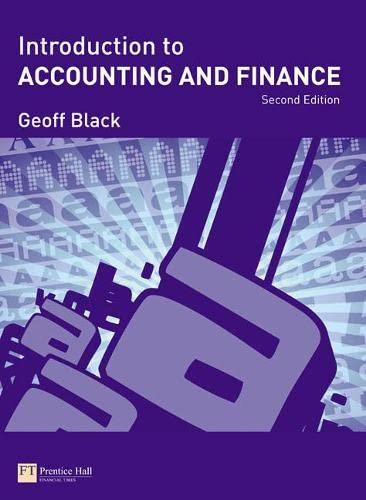Question
Inventory by Three Cost Flow Methods Details regarding the inventory of appliances on January 1, 20Y7, purchases invoices during the year, and the inventory count
Inventory by Three Cost Flow Methods
Details regarding the inventory of appliances on January 1, 20Y7, purchases invoices during the year, and the inventory count on December 31, 20Y7, of Amsterdam Appliances are summarized as follows:
| Purchases Invoices | |||||||||||||||
| Model | Inventory, January 1 | 1st | 2nd | 3rd | Inventory Count, December 31 | ||||||||||
| A10 | 4 at $ 64 | 4 at $ 70 | 4 at $ 76 | 6 | |||||||||||
| B15 | 8 at $176 | 4 at 158 | 3 at 170 | 6 at 184 | 8 | ||||||||||
| E60 | 3 at 75 | 3 at 65 | 15 at 68 | 9 at 70 | 5 | ||||||||||
| G83 | 7 at 242 | 6 at 250 | 5 at 260 | 10 at 259 | 9 | ||||||||||
| J34 | 12 at 240 | 10 at 246 | 16 at 267 | 16 at 270 | 15 | ||||||||||
| M90 | 2 at 108 | 2 at 110 | 3 at 128 | 3 at 130 | 5 | ||||||||||
| Q70 | 5 at 160 | 4 at 170 | 4 at 175 | 7 at 180 | 8 | ||||||||||
Instructions:
1. Determine the cost of the inventory on December 31, 20Y7, by the first-in, first-out method.
If the inventory of a particular model comprises one entire purchase plus a portion of another purchase acquired at a different unit cost, use a separate line for each purchase. Under FIFO, if a model is in inventory at two different costs, enter the remaining units that were purchased most recently first.
| First-In, First-Out Method | ||||
| Model | Quantity | Unit Cost | Total Cost | |
| A10 | $ | $ | ||
| B15 | ||||
| E60 | ||||
| G83 | ||||
| J34 | ||||
| M90 | ||||
| Q70 | ||||
| Total | $ | |||
2. Determine the cost of the inventory on December 31, 20Y7, by the last-in, first-out method, following the procedures indicated in (1). Under LIFO, if a model is in inventory at two different costs, enter the remaining units that were purchased earliest first.
| Last-In, First-Out Method | ||||
| Model | Quantity | Unit Cost | Total Cost | |
| A10 | $ | $ | ||
| B15 | ||||
| E60 | ||||
| G83 | ||||
| J34 | ||||
| M90 | ||||
| Q70 | ||||
| Total | $ | |||
3. Determine the cost of the inventory on December 31, 20Y7, by the average cost method.
| Average Cost Method | ||||
| Model | Quantity | Unit Cost | Total Cost | |
| A10 | $ | $ | ||
| B15 | ||||
| E60 | ||||
| G83 | ||||
| J34 | ||||
| M90 | ||||
| Q70 | ||||
| Total | $ | |||
4. Which method (FIFO or LIFO) would be preferred for income tax purposes in periods of rising prices? LIFO
Which method (FIFO or LIFO) would be preferred for income tax purposes in periods of declining prices? FIFO
Feedback
1.In the FIFO method, the first units purchased are assumed to be the first to be sold. Therefore, ending inventory costs for the period are calculated by taking the number of items remaining in the physical inventory times the most recent purchase price. If the number of items in the last purchase layer is less than the number in ending inventory, the balance of the ending inventory items must be recorded at the cost of the second to last purchase cost.
2. In the LIFO method, the last units purchased are assumed to be the first to be sold. Therefore, the remaining ending inventory for the period is made up of the earliest costs from the beginning inventory. If the number of units in the ending inventory is greater than the units in the beginning inventory, the excess units will be recorded at the cost of the first purchase.
3. In the weighted average cost method, the average cost of all available units purchased is applied to the number of units sold and those in ending inventory. Therefore, you must first obtain a unit cost by dividing the total cost of all units available for sale by the number of units available for sale. Then, multiply the number of items remaining in the physical inventory times this unit cost.
4. Recall that the FIFO method reports higher gross profit, net income, and income taxes than the LIFO method when costs (prices) are increasing. Also, rising prices mean that items purchased later will cost more than items purchased earlier. In the case of the FIFO method, the ending inventory costs for the period are calculated based on the most recent prices; consider this cost flow in your answer regarding both inventory and cost of goods sold.
Step by Step Solution
There are 3 Steps involved in it
Step: 1

Get Instant Access to Expert-Tailored Solutions
See step-by-step solutions with expert insights and AI powered tools for academic success
Step: 2

Step: 3

Ace Your Homework with AI
Get the answers you need in no time with our AI-driven, step-by-step assistance
Get Started


